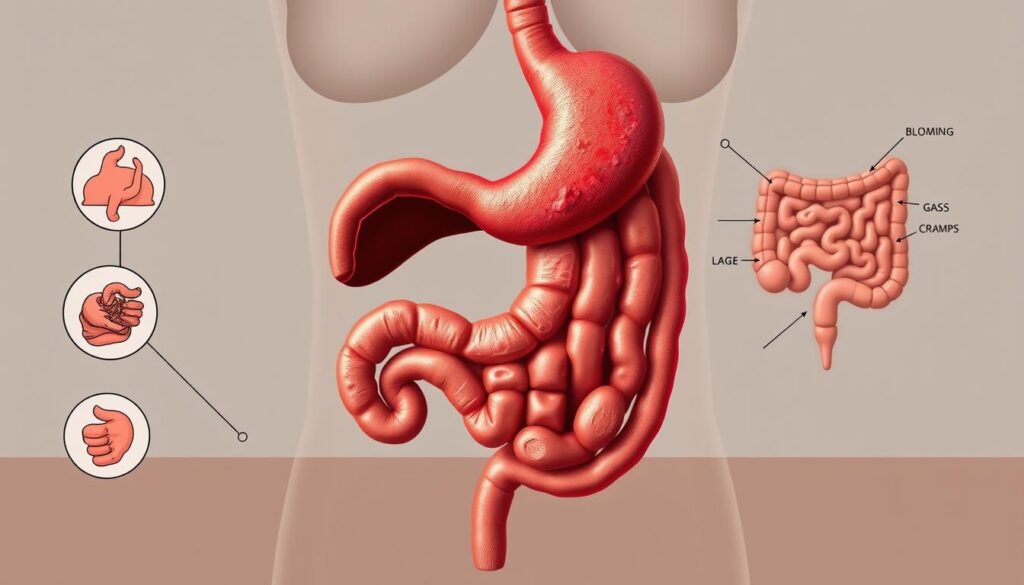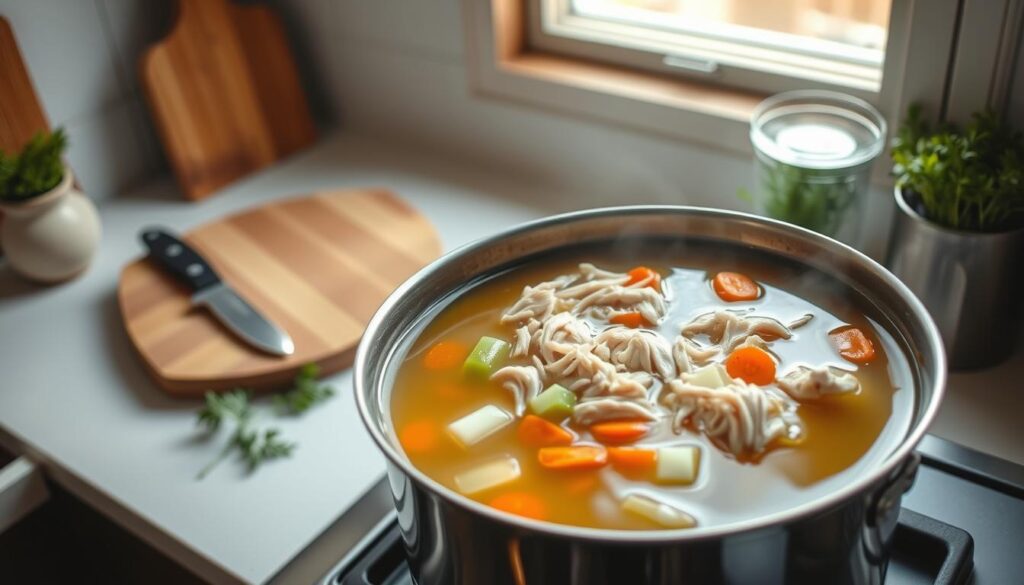My journey with digestive troubles started during a stressful graduate school semester. I was constantly battling stomach discomfort. Then, I found the healing power of a simple chicken recipe for bad stomach. It became my ultimate comfort food.
Dealing with digestive challenges, I learned the value of a gentle, nutritious meal. My easy chicken soup recipe became a beacon of hope. It offered nourishment and relief during tough times.
Chicken has been my go-to for soothing an upset stomach. Its lean protein and essential nutrients make it a healing meal. It supports digestive health and brings much-needed comfort.
Key Takeaways
- Chicken is a gentle protein source for sensitive stomachs
- Easy-to-prepare recipes can provide significant digestive relief
- Nutritional value of chicken supports overall digestive health
- Proper cooking methods enhance digestibility
- Portion control is key for stomach-friendly meals
Understanding a Bad Stomach
Stomach discomfort can really mess up your day. It makes even simple things hard. I’ve had my share of digestive problems. It’s key to know what’s causing it and to watch for signs.

Common Causes of Stomach Discomfort
Digestive problems can come from many places. Here are some main reasons:
- Dietary factors like spicy or fatty foods
- Stress and anxiety
- Viral or bacterial infections
- Food intolerances
- Medications
Symptoms to Watch Out For
Spotting symptoms early can help you handle them better. Keep an eye out for these signs when making bland chicken recipes:
- Persistent nausea
- Abdominal cramping
- Bloating
- Unexpected weight loss
- Changes in bowel movements
When to See a Doctor
While some stomach issues can be handled at home, others need a doctor:
| Symptom | Action Required |
|---|---|
| Severe abdominal pain | Immediate medical consultation |
| Persistent vomiting | Contact healthcare provider |
| Symptoms lasting over 5 days | Professional evaluation |
| Bloody stools | Urgent medical care |
These tips aren’t a replacement for doctor’s advice. Always talk to a healthcare professional if you’re not sure about your symptoms.
Why Choose Chicken Recipe for bad Stomach?
Finding the right food when you have digestive troubles can be tough. Chicken is a lifesaver for those with sensitive stomachs. As a gentle chicken recipe expert, I can say chicken is great for digestive comfort.

Chicken is an excellent protein for those with stomach problems. It’s lean and easy to digest, which is key when your stomach needs a break. Chicken recipes for upset stomach are backed by science and help with nutrition.
Nutritional Powerhouse for Digestion
Here’s why chicken is a nutritional hero for your gut:
- Low in fat, reducing risk of indigestion
- Rich in essential vitamins like B6 and niacin
- Provides easily absorbable protein
- Supports muscle repair and energy levels
Protein That Supports Healing
The protein in chicken is special—it’s good for your digestion. When cooked right, chicken is perfect for those with sensitive stomachs.
| Nutrient | Benefit for Digestion |
|---|---|
| Vitamin B6 | Supports metabolism and gut health |
| Zinc | Aids immune system function |
| Lean Protein | Easy to digest, reduces inflammation |
By choosing chicken, you’re not just eating a meal. You’re giving your body nutritional support to soothe and recover your digestive system.
Essential Ingredients for My Chicken Recipe
When making chicken recipes for digestive issues, picking the right ingredients is vital. You want a meal that’s both healthy and easy on your stomach.

Chicken Selection Tips
For recipes for sensitive stomachs, choose lean chicken cuts. Skinless, boneless chicken breasts are best. They’re low in fat and easy to digest, providing quality protein without upsetting your stomach.
Stomach-Soothing Ingredients
- White rice: A bland, easily digestible grain
- Carrots: Soft and nutritious vegetable
- Fresh ginger: Natural anti-inflammatory properties
- Sea salt: Minimal seasoning for flavor
Essential Kitchen Tools
| Tool | Purpose |
|---|---|
| Large pot | Boiling chicken and preparing broth |
| Sharp knife | Precise chicken cutting |
| Fine-mesh strainer | Removing impurities from broth |
Remember, when making chicken recipes for digestive issues, keep it simple. Use minimal ingredients that help with healing and comfort.
Preparing the Chicken
When making simple chicken recipes for nausea, how you prepare is key. The right cooking method can turn your meal into a gentle, healing dish. This dish supports digestive comfort.
Thawing Techniques for Safe Preparation
Always thaw chicken safely in the fridge. This stops bacteria from growing and keeps your dish safe for sensitive stomachs. Don’t thaw on the counter, as it can introduce harmful bacteria.
- Refrigerator thawing: 24 hours for every 4-5 pounds
- Never use hot water or room temperature thawing
- Keep chicken in its original packaging during thawing
Cooking Methods: Boiling vs. Baking
For meals that ease an upset stomach, I recommend boiling and baking. Both methods are good for your digestive health.
| Cooking Method | Benefits | Preparation Time |
|---|---|---|
| Boiling | Lowest fat content, creates gentle broth, easiest to digest | 15-20 minutes |
| Baking | Retains more nutrients, minimal added fats | 25-30 minutes |
Pro tip: Whichever method you choose, ensure the chicken reaches an internal temperature of 165°F to guarantee food safety.
“Gentle cooking is the key to creating a healing meal for a sensitive stomach.” – Digestive Health Specialist
When preparing chicken for digestive relief, keep it simple. Avoid complex marinades or heavy seasonings. They might irritate a delicate stomach.
The Cooking Process
Making a chicken recipe for a bad stomach needs careful steps and gentle cooking. My easy chicken soup recipe is designed to be nourishing and gentle on your stomach.

Choosing the right cooking method is key when cooking chicken for sensitive stomachs. I use methods that keep nutrients and make digestion easy.
Step-by-Step Cooking Instructions
- Select a skinless chicken breast for lean protein
- Rinse chicken thoroughly under cold water
- Cut chicken into small, even pieces
- Use gentle cooking methods like steaming or pressure cooking
- Ensure internal temperature reaches 165°F
Preventing Digestive Discomfort
To avoid bloating and stomach issues, I follow certain steps when making my chicken recipe:
- Cook chicken thoroughly but avoid overcooking
- Use minimal seasonings
- Chop ingredients into small, easily digestible pieces
| Cooking Method | Cooking Time | Digestibility Rating |
|---|---|---|
| Steaming | 15-20 minutes | Excellent |
| Pressure Cooking | 20 minutes | Very Good |
| Boiling | 25-30 minutes | Good |
My method makes a gentle, nutritious chicken soup. It supports digestive health and gives essential proteins and minerals.
Flavoring My Chicken Recipe
Making stomach soothing chicken dishes is all about finding the right balance. I use gentle seasonings that add flavor without upsetting the stomach. This way, my bland chicken recipes are both tasty and easy on the digestive system.

When I cook chicken for digestive health, I keep it simple. The right herbs can turn a basic dish into a healing meal.
Gentle Seasoning Strategies
I pick herbs and spices that are good for digestion and add a bit of flavor. Here are my favorites:
- Ginger: It’s a natural stomach-soother with anti-inflammatory benefits
- Dried thyme: It helps reduce gas and bloating
- Fresh parsley: It has a mild flavor that can freshen breath
- Minimal salt: Just enough to bring out the chicken’s natural taste
Herbs That Support Digestion
Some herbs do more than just taste good. Digestive-friendly herbs can actually help your gut health. Start with small amounts and see how your body reacts.
Pro tip: Always listen to your body and adjust seasonings as needed.
By choosing ingredients that are easy on the stomach, you can make a tasty chicken dish. It will nourish and support your digestive health.
Serving Suggestions
When making chicken recipes for upset stomach, how you serve it is just as important as how you make it. I aim to create a meal that’s both comforting and supports your digestive health.
Ideal Pairing Options
I suggest serving your gentle chicken with sides that are easy to digest. These sides should enhance the meal’s soothing effects. Here are my top picks:
- Steamed white rice
- Boiled carrots (peeled and soft)
- Plain mashed potatoes
- Clear chicken broth
Plating for Maximum Comfort
The way you plate your meal can greatly affect your dining experience. Gentle chicken recipes need special care when serving. I find it best to use:
- Deep bowls instead of flat plates
- Smaller portion sizes
- Room temperature water nearby
The key is to nourish your body with care and compassion.
Eat slowly, chew well, and pay attention to your body’s signals. Each bite should feel gentle and supportive to your stomach.
Storing Leftovers Safely
After making tasty chicken recipes for sensitive stomachs, it’s key to store leftovers right. I’ve learned from my chicken recipes for digestive issues how important it is to handle food safely. This helps avoid health risks.
When I store my chicken dish, I stick to strict food safety rules. It’s all about knowing the food danger zone. This is when bacteria grow fast, between 40 to 140°F.
Cooling and Refrigerating Techniques
I cool my chicken fast and put it in the fridge within two hours. Here’s what I do:
- Let chicken cool to room temperature
- Use shallow, airtight containers
- Refrigerate at 40°F or below
- Label containers with storage date
Reheating for Sensitive Stomachs
Reheating is important, even more so for chicken recipes for digestive issues. Here’s how I do it:
- Reheat to an internal temperature of 165°F
- Use low, steady heat to prevent drying
- Add a splash of water to maintain moisture
- Avoid multiple reheating cycles
If you’re always feeling stomach sensitive, making new meals is the safest choice.
Conclusion: Enjoying Comfort Food
My simple chicken recipes for nausea have been a big help when I’m not feeling well. They offer both nutrition and comfort. A chicken bone broth is great for soothing a sensitive stomach.
Chicken is lean and has mild flavors, making it perfect for when you’re not feeling right. It has 31 grams of protein per 100 grams and is low in fat. This makes chicken breast a nutritious choice that’s easy on your stomach. It’s important to keep things simple and cook gently.
Try adding different ingredients but listen to your body. Start with the basic recipe and add mild herbs or easy-to-digest foods slowly. Eating smaller meals can also help ease your stomach and help you get better.
Even though this recipe brings comfort, don’t ignore persistent or worsening symptoms. Always talk to a healthcare professional if you’re not feeling better. Your health is the most important thing, and sometimes, you need professional advice to get back on track.



